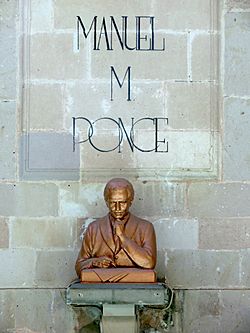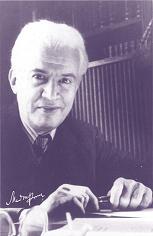Manuel Ponce facts for kids
Manuel María Ponce Cuéllar (born December 8, 1882 – died April 24, 1948) was a famous Mexican composer. He lived in the 20th century. Manuel Ponce helped connect classical concert music with traditional Mexican folk songs. Many of his musical pieces sound like or are based on old Mexican tunes.
Contents
Biography
Early Life
Manuel Ponce was born in Fresnillo, Zacatecas. Just a few weeks after he was born, his family moved to Aguascalientes. He lived there until he was 15 years old.
He was known as a child music genius. When he was only four years old, he listened to his sister Josefina's piano lessons. Then, he sat down at the piano and played one of the songs he had heard! After that, his parents made sure he got piano lessons and learned how to read music.
Studying Abroad
In 1901, Manuel Ponce joined the National Conservatory of Music in Mexico. He was already known as a good pianist and composer. He stayed there until 1903, then went back to Aguascalientes. But this was just the start of his travels. In 1904, he went to Italy to study music at the Conservatorio Giovanni Battista Martini in Bologna.
He also studied in Germany from 1906 to 1908. His teacher there was Martin Krause at the Stern conservatory in Berlin.
Back in Mexico

After his time studying in Europe, Ponce came back to Mexico. He taught piano and music history at the National Conservatory of Music. He taught there from 1909 to 1915, and again from 1917 to 1922. In between those years, from 1915 to 1917, he lived in Havana, Cuba.
In 1912, he wrote his most famous song, "Estrellita" (which means "little star"). Many people think it's a love song, but it's actually about a strong feeling of "live nostalgia."
That same year, Ponce gave a special concert at the "Arbeau Theater." He played Mexican folk music. Some people who loved European classical music were shocked. But this concert became a very important moment for Mexican national music.
Heitor Villa-Lobos (1887–1959), another famous composer, met Ponce in Paris in the 1920s. Villa-Lobos said that Ponce was also working to use his country's folk music. He was happy to know that another artist was fighting for his country's musical independence.
Manuel Ponce helped promote Mexican music. He wrote many popular songs like "Estrellita," "A la orilla de un palmar," and "La Pajarera." Because of his work, he earned the title Creator of the Modern Mexican Song. He was also the first Mexican composer to share popular music with the whole world. "Estrellita," for example, has been played by many orchestras and singers around the globe. Often, people don't even know it's a Mexican song or who wrote it!
In 1947, he received the National Science and Arts Prize. This is a very high award in Mexico.
Manuel Ponce was married to Clementina Maurel. He passed away in Mexico City. His body was buried in the Roundhouse of the Illustrious Men in the Pantheon of Dolores in Mexico City. There is a special plaque in Aguascalientes to honor him. It is near a fountain where he grew up and first learned music.
Recordings
Manuel Ponce played in some recordings:
- Concierto para piano y orquesta (Ponce played the piano; Orquesta Sinfónica de México; led by Carlos Chávez) (1942)
He also recorded some of his works on special Duo-Art piano rolls between 1916 and 1920. These rolls could play music on a player piano.
- Ponce - Mexican Barcarolle
- Ponce - Cuban Serenade
- Ponce - Moonlight
- Ponce - Quando vene la Primavera (When Spring Comes)
Music
Ponce wrote music for many different instruments. He wrote for solo instruments, small groups of instruments (chamber ensembles), and full orchestras. He wrote a lot of pieces for piano and guitar. His song Estrellita is his most famous work.
Guitar Music
Ponce's guitar music is very important for guitar players. His best-known guitar pieces are Variations and Fugue on 'La Folia' (1929) and Sonatina meridional (1939). He also wrote a guitar concerto called Concierto del sur. He dedicated this concerto to his good friend, the amazing guitar player Andrés Segovia.
Here are some of his important guitar pieces:
- Scherzino Mexicano (1909)
- 24 Preludes
- Sonata mexicana (1923)
- Sonata clásica (1928)
- Sonata romántica (1929)
- Variations and Fugue on 'La Folia' (1929)
- Sonatina meridional (1939)
- Concierto del sur (1941)
Ponce also secretly arranged a famous piece by J. S. Bach for the guitar. This arrangement was played and recorded by Segovia.
Piano Works
Manuel Ponce wrote many pieces for the piano. Here are some of them:
- Suite Cubana
- Cuatro Danzas Mexicanas
- Balada Mexicana
- Mazurcas
- Concierto romántico para piano y orquesta
- 4 Scherzinos
- Estudios de concierto
- Rapsodias Mexicanas
Songs
Ponce wrote many original songs. Here are a few:
- "Adiós mi bien"
- "Alevántate
- "Estrellita" (1912)
- "La pajarera"
- "Marchita el alma"
- "Por tí mi corazón"
- "Una multitud más"
He also arranged many traditional Mexican folk songs. This means he took old songs and wrote them down with new musical parts. Some of these include:
- "A la orilla de un palmar"
- "Cielito lindo"
- "La barca del marino"
- "La Valentina"
- "Palomita"
Chamber Music
Chamber music is written for a small group of instruments. Ponce wrote:
- Miniatures for violin, viola, and cello (1927)
- Quartet for 2 violins, viola, and cello (1932)
- Sonata a dúo for violin and viola (1936–1938)
- Trio for violin, viola, and cello (1943)
- Sonata for cello and piano
Orchestral Works
Ponce also wrote music for a full orchestra. Some of these pieces are:
- Chapultepec
- Cantos y danzas de los antiguos mexicanos (Songs and Dances of the Ancient Mexicans)
- Ferial
Concertos
A concerto is a piece of music for a solo instrument and an orchestra. Ponce wrote:
- Concierto Romántico for piano and orchestra (1910)
- Concierto del sur for guitar and orchestra (1941)
- Violin Concerto (1943)
See also
 In Spanish: Manuel M. Ponce para niños
In Spanish: Manuel M. Ponce para niños



